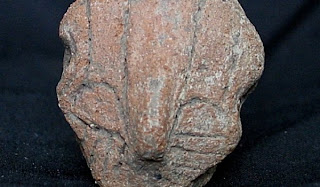Uivar is a late Neolithic - early Eneolithic fortified tell site belonging to the Vinča culture, located in Timiş County, Banat, western Romania. Ten years ago, the archaeologists Florin Draşovean from Timişoara and Wolfram Schier from Wurtzburg began the exploration of the site in Uivar, making several discoveries which had revolutionized the way the Neolithic society was considered by now.
The fortress
The study of the archeomagnetic plan, whose precise outline has been generally confirmed by the excavation, permits a very accurate model of the settlement organization to be constructed. It can clearly be seen that the settlement was protected by a fortification system made up of several concentric ditches that enclosed a central area, a settlement with proto-urban character, a real "akropolis". The fortification system of Uivar is one of the most elaborate and complex ones from this part of Europe. Though built in several stages, it is the result of a unitary defense conception being made up of a double ditch ring and stockades that protected the central area and additional concentric ditches, 3.5 m deep, outwardly laid out beyond the central ring. The digging of defense ditches at Uivar led to the removal of more than 10,000 cubic m (!) of soil of which more than half is yellow clay.The fortification ditches, in addition to protecting a certain area of the site, were also used to delimit several areas for specific functions within the social space. While the akropolis was meant for habitation-, social life-, and spiritual life-related purposes, the inner ring space and the outer ring space had different purposes.
The akropolis
It is apparent that most houses are laid out on two concentric circles surrounding a possible square at the heart of the tell. At the same time, most houses are perpendicular to the inner fortification ring that belongs to the final, third stage, of the defense system development. All this information bears out the idea of a well-conceived settlement plan that was followed by the Neolithic inhabitants of Uivar. This plan underwent alterations over time due to the necessity of the enlarging the habitation area beyond the akropolis, under the standing conflict for space between the area outlined by the fortification and the continuously expanding population. This conflict was resolved very efficiently and, using a modern term, with professionalism, via the already mentioned southward enlargement of the area allotted for dwelling.
Neolithic villas
This need for more room is also reflected by the enlargement and two-storied design of some houses. One of these is a feature, whose development could be determined throughout its use life. Having its long axis running north-east to south-west, the structure has imposing dimensions (14 m x 6 m) and was made up of ground floor and upper floor. Most significant is its final stage in which the structure was to have three rooms of which the one to the west was covered by the flooring of an upper storey. This organization into three rooms and two stories did not exist in the structure’s first stage, and was added only in the last construction stage. This building had a purpose beyond its profane use, thus taking on a ritual role, and namely that of a sanctuary. Two-storey houses crop up in the Carpathian area in the late Neolithic and are strongly correlated with the appearance of tells.
The mask
In the Neolithic settlement were discovered pots, carved and polished stone tools, clay idols. But by far the most sensational discovery is a fragment of a mask of clay, brought to the surface in 2001, which, so far, is unique in Europe. "The piece is a half of a mask, one can see the eyes and mouth. It is a ritual mask used by tribal shamans, which was intended to turn a man into god. An analogy might be a statue discovered in Caraş-Severin, who has in hand a mask such as this one, because in the primitive world, this was an accessory of those who practiced magic", explains Florin Draşovean the meaning of the mask.
From Muzeul Banatului and other minor sources.
Tour: Plantelor area
1 week ago








0 comments:
Post a Comment